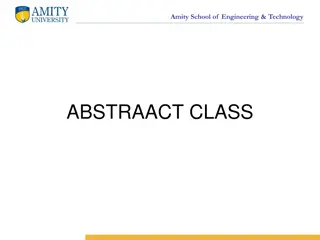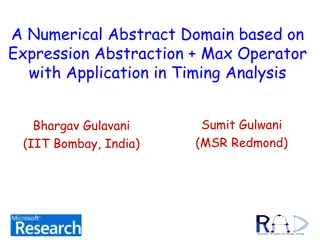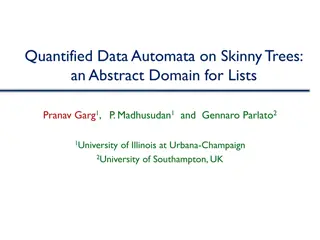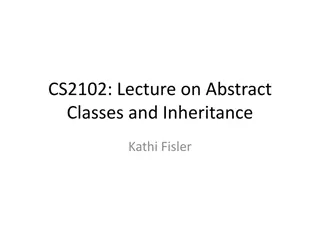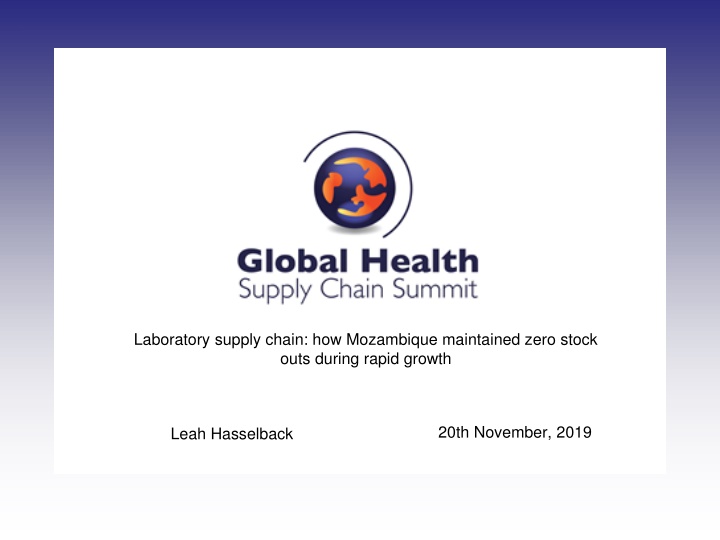
Mozambique Laboratory Supply Chain Success Story Revealed
Discover how Mozambique effectively managed zero stock outs in their laboratory supply chain during a period of rapid growth, as discussed by Leah Hasselback at the Global Health Supply Chain Summit. Despite facing economic challenges and a high HIV prevalence, significant investments and strategic interventions have been made to address these issues and improve healthcare services in the country.
Download Presentation

Please find below an Image/Link to download the presentation.
The content on the website is provided AS IS for your information and personal use only. It may not be sold, licensed, or shared on other websites without obtaining consent from the author. If you encounter any issues during the download, it is possible that the publisher has removed the file from their server.
You are allowed to download the files provided on this website for personal or commercial use, subject to the condition that they are used lawfully. All files are the property of their respective owners.
The content on the website is provided AS IS for your information and personal use only. It may not be sold, licensed, or shared on other websites without obtaining consent from the author.
E N D
Presentation Transcript
Laboratory supply chain: how Mozambique maintained zero stock outs during rapid growth 20th November, 2019 Leah Hasselback
Laboratory Supply Chain: How Mozambique Maintained Zero Stock Outs During Rapid Growth Leah Hasselback USAID/Mozambique 2019 Global Health Supply Chain Summit, Johannesburg, S. Africa
Mozambique: A Big Country with Big Challenges Coastline equivalent to the U.S. east coast Low income country with a worsening economic situation GDP fell from $16.9 billion in 2014 to $11 billion in 2016 60% of Mozambicans live on <$1.25 per day GNI per capita fell from $620 in 2014 to $480 in 2016 180 out of 188 on UN Development Index Low health care worker education requirements Technicians require 10thgrade + 1.5 years of training 10% of Mozambicans live within a 1 hour walk to a health facility 2019 Global Health Supply Chain Summit, Johannesburg, S. Africa
Significant Investments to Address Mozambique s HIV Epidemic 2.2 million people living with HIV/AIDS 12.6% prevalence Growing number of people on treatment, but a long way to go 49% viral load coverage rate 79% suppression rate $330 million PEPFAR investment in fiscal year 2020 USAID invests approximately $80 million in commodities and supply chain annually $27.5 million FY20 investment in reagents for Viral Load and Early Infant Diagnosis Testing Number of People on Antiretroviral Therapy in Mozambique Source: PEPFAR 1,200,000 1,000,000 800,000 600,000 400,000 200,000 - 2016 2017 2018 2019 2019 Global Health Supply Chain Summit, Johannesburg, S. Africa
Introducing Viral Load in Mozambique First viral load instruments were purchased and suffered many breakdowns Local vendor holding the maintenance contract had insufficient technical capacity and incentive Reagents were purchased separately from instruments and lead times didn t allow for flexibility regarding machine down time 2019 Global Health Supply Chain Summit, Johannesburg, S. Africa
Quantifying Commodity Need is Complex Target population considerations: PLHIV PBW Testing Algorithm: How many tests does our target population need? What is the suspected treatment failure rate? What regimens are we using? Laboratory Instruments: What instruments do we have? What testing capacity do we need? Where do we need the testing capacity? What infrastructure do we have/need? When will it be ready? What is the right mix of instrument types? 67 SKUs Other Considerations: What sample type can we use/do the instruments use? What other equipment do we need? How will we grow the laboratory network? What will our uptake and demand be? 2019 Global Health Supply Chain Summit, Johannesburg, S. Africa
How do we build flexibility in the supply chain? Challenges Opportunities Incentive Alignment Dynamic context Large number of commodities Volume Private Sector Weak systems Reagent Rental Agreement Using all inclusive pricing in a contract with a local vendor, we aligned supplier and public health incentives to offer uninterrupted viral load testing. 2019 Global Health Supply Chain Summit, Johannesburg, S. Africa
Why Reagent Rental? We buy reagents, not instruments. Reagent price includes maintenance and distribution (DDP Incoterms) The vendor makes money by making sure the instruments are working Reagent rental agreement signed in 2017 with GHSC-PSM Benefits Network visibility Align instrument deployments with commodity needs Simplify protocol transitions (commodities and software) Supply plan adjustments Cold chain transportation Stock redistribution Chain of custody Challenges Who to contact for stock and breakdowns Reduced incentive to fix external causes of breakdowns 2019 Global Health Supply Chain Summit, Johannesburg, S. Africa
Flexibility in the Reagent Rental Model Responsiveness to demand 2019 cyclones Samples and reagents were rerouted to other labs Responsibility for repairing damaged instruments with the vendor Simplifying scaling up Vendor manages instruments awaiting lab construction delays Vendor ensures reagents are available when instruments are installed 2019 Global Health Supply Chain Summit, Johannesburg, S. Africa
Results Using this approach, Mozambique achieved a 26-fold increase in viral load testing over 3 years and never an interruption to testing due to reagent stock outs. Following this experience, the Ministry of Health adopted the same approach for laboratory procurements. 2019 Global Health Supply Chain Summit, Johannesburg, S. Africa
Monitoring Performance Key performance management measures Weekly breakdown monitoring Monthly breakdown review meetings Monthly stock monitoring Equipment utilization & contribution 2019 Global Health Supply Chain Summit, Johannesburg, S. Africa
Whats Next? Addressing some of the challenges Reducing breakdowns Improving data collection Improving infrastructure Network reallocation Vendor managed inventory approach Commercial vendor to manage the whole supply chain Network diagnostic optimization Is there a better way we can organize our network and specimen referral systems to ensure the best patient access to testing services? GHSC-PSM launched a global RFP in February 2019 Continued viral load testing growth 2019 Global Health Supply Chain Summit, Johannesburg, S. Africa
Conclusions Incentive alignment is key to an effective supply chain. Local representatives of manufacturers can facilitate more efficient order management and commodity logistics The right private sector engagement can bring flexibility, adaptability, and high quality standards to the supply chain, even in complex and dynamic environments. Strong contract management is critical 2019 Global Health Supply Chain Summit, Johannesburg, S. Africa
Thanks to our generous sponsors 2019 Global Health Supply Chain Summit, Johannesburg, S. Africa




